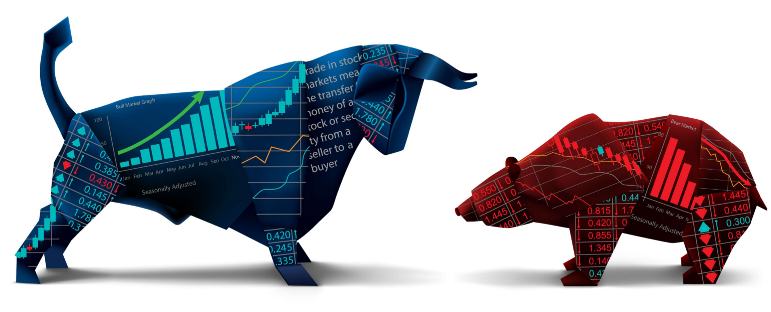Table of Contents
When it comes to investing, Bull and Bear are popular terms used frequently to give details on the market condition and every general activity of the market. The Bull and Bear market explains whether the value of currencies in the market is appreciating or depreciating. As an investor, the direction the market takes has an essential role to play in your portfolio; that’s why the understanding of the bear and bull market condition is of the essence.

Bull and Bear Market Explained
The Bull market is constantly on the rise whenever the market economy is sound. Still, the bear market usually exists in a market where the economy is receding, and its stocks decline in value. As an investor, you can either be bearish or bullish, but most investors are bullish because it has a greater chance of profits. Undeniably, the stock market generally tends to post positive returns for a long period of time.
The bear market becomes volatile when equities lose their value and their price. It is a dangerous market to invest in, but investors that are high-risk-takers invest in those markets. Since it is difficult to determine the bear market, investors sometimes withdraw their money from the bear market and choose to wait until the trend reverses, making prices lower.
The bull market is on the rise whenever the economy is favorable. Due to these facts, investors’ attitudes influence the financial market. This also shows how they feel about the market, and the ensuing economic trends sustained price increase denotes the bull markets. In the equity markets, the bull market shows a rise in the company’s share prices. During these times, investors hope that the uptrend will go on for a long period of time. During situations like this, the country’s economy is strong, and employment is usually high.
Difference between the two markets
On the contrary, the bear market is always on a downtrend or decline. In considering or recognizing the bear market, there is usually a fall in its percentage of about 20% or more. In this market, the share price is constantly dropping. This is why a downtrend and investors of this market have faith that it will continue to rise. How you identify the bear market is that the economy is usually slowed down, and the level of unemployment is constantly on the rise, which the company has no choice but to lay off working staff.
HOW THE BEAR AND BULL ARE CHARACTERIZED
Based on the facts, a bear or bull market is identified by the direction of its stock prices. However, there are some accompanying factors that, as an investor, you should be aware of and have in-depth knowledge about.
When it comes to supply and demand securities, the bull market has a strong demand base and a weak supply. This Implies that many investors are willing to buy securities, but just a handful of them are willing to sell. Investors’ these detectors, the share prices continue to rise as investors compete to acquire available equity. In the bear market is vice-versa, its investors are looking forward to selling rather than buy. Demand is highly lower than supply, and this results in a drop in the share price.
The sentiment and psychology of investors affect whether the market will rise or fall. Investors’ psychology and the stock market performance are mutually dependent on the other. In the bull market, it’s investors are willing to participate with the hope of accumulating profits. It is different in the bear market as the sentiment is usually negative.
What happens is that investors begin to move their money out of equities into fixed income securities, waiting for a positive move in the stock market. This makes the bear investors hold onto their money, restraining it from the market, and this causes price decline as the outflow increases.
What happens during Bull and Bear Market Conditions
Businesses whose stocks are on the exchanges are partakers in the greater economy both the economy and the stock market are powerfully linked. Based on the economy’s weakness associated with the bear market, most businesses cannot account for higher profits because their consumers are not spending enough. This decline directly affects the market values stocks. Unlike the bull market, where individuals are willing to spend more money, this strengthens and drives the economy.
One of the major determinants of the market condition being bear or bull is how the market performs over a long period of time, not the market knee-jerk reaction to particular events. A small movement in the market shows a short term market correction. Whether there is a bull or bear, the only determinant of the market is the legibility of the period of time.
However, not all long movements in the market are assumed or attributed as bull or bear. Sometimes the market goes through a stagnation or consolidation period trying to find its direction; when this occurs, series of uptrends and downtrends would have actually canceled out profits and losses, which leads to a fiat market trend.
OPERATIONS IN THE BULL AND BEAR MARKET
In the bull market, the investors take advantage of the increasing prices by purchasing stocks when the trends are just forming and then decide to sell when they reach the peak. During this movement in the bull market, it would have a minimal and temporal effect if there be any losses. Investors can confidently invest more equity with a greater possibility of market greater profits.
In the bear market, the chances of having losses are higher because its prices are constantly losing value, and its recovery is nearly impossible. Investors who decide to invest in the bear market with the hope of an upturn have greater chances of encountering losses before experiencing an upturn. Bear investors can only have profits in short selling or safer investments like fixed income securities.
Investors may decide to turn to defensive stocks. Its utilities are necessities that people patronize irrespective of the economic conditions. Investors may also benefit from taking short trades in the bear market and make profits before the market decides to decline. Several ways of achieving this include buying put options, short selling, or buying exchange-traded funds (ETFs). Both the bear and bull greatly influence your investments as an investor, which is why it is important to carefully deliberate on what market and the market’s reaction before making an investment decision. Not neglecting the fact that the stock market has always shown a positive return.
What to note

It is important to note that the bull market is classified by its general nature of optimism, which comes with positive growth, leading to investors’ greed. It is advisable to act opposite the investing public, especially when choosing between the bull and the bear market.
Therefore investors who take advantage and capitalize on their emotions lookout for quality stocks at lower prices during the bear markets and sell when the bull market regains its value. I believe investors should also take advantage of the greed and fear of making investments when the market is decliselling and selling when it’s rising, taking advantage of the bulls and bears when they move in the opposite diosite of what most people the market place.





No Comment